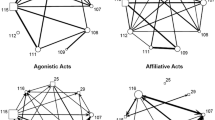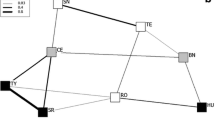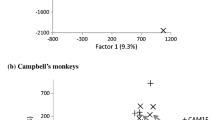Abstract
For species of primates in which females emigrate, we would expect males within groups to be related to one another. Kin selection theory suggests that these males should associate preferentially with one another, be more affiliative and cooperative with one another than females are, and compete less overtly with one another over reproductive opportunities than males in female philopatric taxa do. Precisely these patterns of social behavior characterize well-studied populations of 2 of the 3 atelin primate genera: spider monkeys (Ateles) and muriquis (Brachyteles). For the third atelin genus, Lagothrix, patterns of intragroup social behavior have been less well-documented. We studied the social and reproductive behavior of lowland woolly monkeys (Lagothrix lagotricha poeppigii) in Ecuador during a one-year observational study and subsequently used molecular techniques to investigate population genetic structure and dispersal patterns for this taxon.
Among adult male woolly monkeys, both affiliative and agonistic interactions were rare, and males were seldom in close proximity to one another. Relationships among male woolly monkeys are best characterized as tolerant, especially in the context of mating wherein direct competition among males was minimal despite the fact that females mated with multiple males. Relationships among females were likewise generally tolerant but nonaffiliative, though females often directed harassment towards copulating pairs. Affiliative interactions that did occur among woolly monkeys tended to be directed either between the sexes—primarily from female to male—or from younger towards older males, and the proximity partners of females tended to be members of the opposite sex. These results suggest that bonds between the sexes may be more important than same-sex social relationships and that direct female-female competition is an important feature of woolly monkey reproductive biology. Our genetic results indicate that, as in other atelins, dispersal by females is common, but some male dispersal likely occurs as well. In some but not all groups we studied, nonjuvenile males within social groups were more closely related to one another on average than females were, which is consistent with greater male than female philopatry. However, differences in these patterns among our study groups may reflect local variation in dispersal behavior.
Similar content being viewed by others
References
Altmann, J. (1974.) Observational study of behavior: Sampling methods. Behaviour 49: 227–262.
Altmann, J. (1997). Mate choice and intrasexual reproductive competition: Contributions to reproduction that go beyond acquiring more mates. In Feminism and Evolutionary Biology: boundaries, intersections, and frontiers (P. Gowaty, ed). Chapman Hall.
Belkhir, K., Borsa, P., Chikhi, L., Raufaste, N., and Bonhomme, F. (2003). GENETIX 4.04, logiciel sous Windows TM pour la génétique des populations. Laboratoire Génome, Populations, Interactions, CNRS UMR 5171, Université de Montpellier II, Montpellier (France).
Campbell, C. J. (2000). The Reproductive Biology of Black-Handed Spider Monkeys (Ateles geoffroyi): Integrating behavior and endocrinology. Ph.D. Dissertation: University of California, Berkeley.
Cant, J. G. H. (1977). Ecology, Locomotion, and Social Organization of Spider Monkeys (Ateles geoffroyi). Ph.D. Dissertation University of California, Davis.
Chapais, B. (2001). Primate nepotism: What is the explanatory value of kin selection? Int. J. Primatol. 22: 203–229.
Chapman, C. (1988). Patterns of foraging and range use by three species of neotropical primates. Primates 29: 177–194.
Capman, C. A. (1990a). Association patterns of spider monkeys: The influence of ecology and sex on social organization. Behav. Ecol. Sociobiol. 26: 409–414.
Chapman, C. A. (1990b). Ecological constraints on group size in three species of neotropical primates. Folia Primatol. 55: 1–9.
Di Fiore, A. (1997). Ecology and Behavior of Lowland Woolly Monkeys (Lagothrix lagotricha poeppigii, Atelinae) in Eastern Ecuador. Ph.D. Dissertation, University of California, Davis.
Di Fiore, A. (2001). Investigación ecológica y de comportamiento de primates en el Parque Nacional Yasuní. In Jorgenson J. P., and Coello M. R. (eds.), Conservación y Desarollo Sostenible del Parque Nacional Yasuní y su Área de Influencia: memorias del seminario-taller Yasuní Quito, Ecuador: Editorial SIMBIOE, pp. 165–173.
Di Fiore, A. (2002). Molecular perspectives on dispersal in lowland woolly monkeys (Lagothrix lagotricha poeppigii). Am. J. Phys. Anthropol. S34: 63.
Di Fiore, A. (2003). Ranging behavior and foraging ecology of lowland woolly monkeys (Lagothrix lagotricha poeppigii) in Yasuní National Park, Ecuador. Am. J. Primatol. 59: 47–66.
Di Fiore, A. (In press). A rapid genetic method for sex assignment in nonhuman primates Conservation Genetics.
Di Fiore, A., and Campbell, C. J. (In press). The atelines: Variation in ecology, behavior, and social organization. In Bearder, S. Campbell, C. J. Fuentes, A. MacKinnon, K. C., and Panger, M. (eds.), Primates in Perspective Oxford University Press. Oxford.
Di Fiore, A., and Fleischer, R. C. (2004). Microsatellite markers for woolly monkeys (Lagothrix lagotricha) and their amplification in other New World primates (Primates: Platyrrhini). Mol. Ecol. Notes 4: 246–249.
Di Fiore, A., and Rodman, P. S. (2001). Time allocation patterns of lowland woolly monkeys (Lagothrix lagotricha poeppigii) in a neotropical terra firma forest. Int. J. Primatol. 22: 449–480.
Evett, I. W., and Weir, B. S. (1998). Interpreting DNA Evidence: Statistical Genetics for Forensic scientists. Sunderland, MA, Sinauer.
Fedigan, L. M., and Baxter, M. J. (1984). Sex differences and social organization in free-ranging spider monkeys (Ateles geoffroyi). Primates 25: 279–294.
Gagneux, P., Boesch, C., and Woodruff, D. S. (1999). Female reproductive strategies, paternity and community structure in wild West African chimpanzees. Anim. Beha. 57: 19–32.
Goodall, J. (1986). The Chimpanzees of Gombe: Patterns of behavior. Cambridge, MA: Belknap Press.
Goodnight, K. F., and Queller, D. C. (1999). Computer software for performing likelihood tests of pedigree relationship using genetic markers. Mol. Ecol. 8: 1231–1234.
Goudet, J. (2001). FSTAT, a program to estimate gene diversity and fixation indices (version 2.9.3), Institute of Ecology, Laboratory for Zoology, University of Laussane.
Gouzoules, H., and Gouzoules, S. (1987). Kinship. In Smuts, B. B., Cheney, D. L., Seyfarth, R. M., Wrangham, R. W., and Struthsaker, T. T. (eds.), Primate Societies. University of Chicago Press Chicago: pp. 299–305.
Hamilton, M. B., Pincus, E. L., Di Fiore, A., and Fleischer, R. C. (1999). Universal linker and ligation procedures for construction of genomic DNA libraries enriched for microsatellites. BioTechniques 27: 500–507.
Karesh, W. B., Smith, F., and Frazier-Taylor, H. (1987). A remote method for obtaining skin biopsy samples. Cons. Biol. 1: 261–262.
Klein, L. L. (1972). The Ecology and Social Behavior of the Spider Monkey, Ateles belzebuth. Ph.D. Dissertation, University of California, Berkeley.
Kocher, T. D., Thomas, W. K., Meyer, A., Edwards, S. V., Pääbo, S., Villablanca, F. X., and Wilson, A. C. (1989). Dynamics of mitochondrial DNA evolution in animals: Amplification and sequencing with conserved primers. Pro. Nat. Acad. Sci., USA 86: 6196–6200.
Lindburg, D. G. (1971). The rhesus monkey in northern India: An ecological and behavioral study. In Rosenblum, L. A. (ed.), Primate Behavior, vol. 2. New York: Academic Press pp. 1–106.
Lopez, J. V., Yuhki, N., Masuda, R., Modi, W., and O'Brien, S. J. (1994). Numt, a recent transfer and tandem amplification of mitochondrial DNA to the nuclear genome of the domestic cat. J. Mol. Evol. 39: 174–191.
Marshall, T. C., Slate, J., Kruuk, L. E. B., and Pemberton, J. M. (1998). Statistical confidence for likelihood-based paternity inference in natural populations. Mol. Ecol. 7: 639–655.
Milton, K. (1985). Mating patterns of woolly spider monkeys, Brachyteles arachnoides: implications for female choice. Behav. Ecol. Soc. 17: 53–59.
Morin, P. A., Moore, J. J., Chakraborty, R., Jin, L., Goodall, J., and Woodruff, D. S. (1994). Kin selection, social structure, gene flow, and the evolution of chimpanzees. Science 265: 1193–1201.
Nishida, T., and Hiraiwa-Hasegawa, M. (1987). Chimpanzees and bonobos: Cooperative relationships among males. In Smuts, B. B., Cheney, D. L., Seyfarth, R. M., Wrangham, R. W., and Struhsaker, T. T. (eds.), Primate Societies University of Chicago Press Chicago pp. 165–178.
Nishimura, A. (1988). Mating behavior of woolly monkeys, Lagothrix lagotricha, at La Macarena, Columbia. Field Studies of New World Monkeys, La Macarena, Colombia 1: 19–27.
Nishimura, A. (1990a). Mating behavior of woolly monkeys (Lagothrix lagotricha) at La Macarena, Columbia (II): mating relationships. Field Studies of New World Monkeys, La Macarena, Colombia 3: 7–12.
Nishimura, A. (1990b). A sociological and behavioral study of woolly monkeys, Lagothrix lagotricha, in the Upper Amazon. Sci. Eng. Rev. Doshisha University 31: 87–121.
Nishimura, A. (1994). Social interaction patterns of woolly monkeys (Lagothrix lagotricha): A comparison among the atelines. Sci. Eng. Rev. Doshisha University 35: 236–254.
Nishimura, A., Fonseca, G. A. B., Mittermeier, R. A., Young, A. L., Strier, K. B., and Valle, C. M. C. (1988). The muriqui, genus Brachyteles. In Mittermeier, R. A., Rylands, A. B., Coimbra-Filho, A. F., and da Fonseca, G. A. B. (eds.), Ecology and Behavior of Neotropical Primates, vol. 2. World Wildlife Fund Washington, DC, pp. 577–610.
Nishimura, A., Wilches, A. V., and Estrada, C. (1992). Mating behaviors of woolly monkeys, Lagothrix lagotricha, at La Macarena, Colombia (III): Reproductive parameters viewed from a longterm study. Field Studies of New World Monkeys, La Macarena, Colombia 7: 1–7.
Paetkau, D., and Strobeck, C. (1994). Microsatellite analysis of genetic variation in black bear populations. Mol. Ecol. 3: 489–495.
Pitman, N. C. A., Terborgh, J., Silman, M. R., and Nuñez, V. P. (1999). Tree species distributions in an Upper Amazonian forest. Ecology 80: 2651–2661.
Pope, T. R. (1992). The influence of dispersal patterns and mating systems on genetic differentiation within and between populations of the red howler monkey (Alouatta seniculis). Evolution 46: 1112–1128.
Pusey, A. E., and Packer, C. (1987). Dispersal and philopatry. In Smuts, B. B., Cheney, D. L., Seyfarth, R. M., Wrangham, R. W., and Struhsaker, T. T. (eds.), Primate Societies University of Chicago Press. Chicago, pp. 250–266.
Queller, D. C., and Goonight, K. F. (1989). Estimating relatedness using genetic markers. Evolution 43: 258–275.
Romoleroux, K., Foster, R., Valencia, R., Condit, R., Balslev, H., and Losos, E. (1997). Arboles y arbustos encontrados en dos hectáres de un bosque de la Amazonia ecuatoriana. In Valencia, R., and Balslev, H. (eds.), Estudios sobre Diversidad y Ecología de Plantas Ecuador Quito, Pontificia Universidad Católica del Ecuador, pp. 189–215.
Rosenberger, A. L., and Strier, K. B. (1989). Adaptive radiation of the ateline primates. J. Hum. Evol. 18: 717–750.
Sekulic, R. (1983). Male relationships and infant deaths in red howler monkeys (Alouatta seniculus). Zeitschrift für Tierpsychologie 61: 185–202.
Seyfarth, R. M. (1976). Social relationships among adult female baboons. Anim. Behav. 24: 917–938.
Smuts, B. B. 1985. Sex and Friendship in Baboons. New York: Aldine de Gruyter.
Smuts, B. B. (1987). Sexual competition and mate choice. In Smuts, B. B., Cheney, D. L., Seyfarth, R. M., Wrangham, R. W., and Struhsaker, T. T. (eds.), Primate Societies, University of Chicago Press. Chicago, pp. 385–399.
Starin, E. D. (1994). Philopatry and affiliation among red colobus. Behavior 130: 253–270.
Stevenson, P. R., Quiñones, M. J., and Ahumada, J. A. (1994). Ecological strategies of woolly monkeys (Lagothrix lagotricha) at Tinigua National Park, Colombia. Am. J. Prim. 32: 123–140.
Strier, K. B. (1985). Reprodução de Brachyteles arachnoides. In de Mello, M. T. (ed.), A Primatologia no Brasil, vol. 2. Sociedade Brasileira de Primatologia. Brasilia.
Strier, K. B. (1986). The Behavior and Ecology of the Woolly Spider Monkey, or Muriqui (Brachyteles arachnoides E Geoffroy 1806). Ph.D. Dissertation, Harvard University.
Strier, K. B. (1990). New World primates, new frontiers: Insights from the woolly spider monkey, or muriqui (Brachyteles arachnoides). Int. J. Primalol. 11: 7–19.
Strier, K. B. (1991). Demography and conservation of an endangered primate, Brachyteles arachnoides. Cons. Biol. 5: 214–218.
Strier, K. B. (1992). Atelinae adaptations: Behavioral strategies and ecological constraints. Am. J. Phy. Anthropol. 88: 515–524.
Strier, K. B. (1994a). Brotherhoods among atelins: Kinship, affiliation, and competition. Behavior 130: 151–167.
Strier, K. B. (1994b). The myth of the typical primate. Yearbook Phy. Anthropol. 37: 233–271.
Strier, K. B. (1997a). Mate preferences of wild muriqui monkeys (Brachyteles arachnoides): Reproductive and social correlates. Folia Primatol. 68:120–133.
Strier, K. B., (1997b). Subtle cues of social relations in male muriqui monkeys (Brachyteles arachnoides). In Kinzey, W. G. (ed.), New World Primates: ecology, evolution, and behavior Aldine de Gruyter New York, pp. 109–118.
Strier, K. B., Carvalho, D. S., and Bejar, N. O. (2000). Prescription for peacefulness. In Aureli, F., and de Waal, F. B. M. (eds.), Natural Conflict Resolution Los Angeles, University of California Press, pp. 315-317.
Strier, K. B., Dib, L. T., and Figueira, J. E. C. (2002). Social dynamics of male murquis (Brachyteles arachnoides hypoxanthus). Behaviour 139: 315–342.
Struhsaker, T. T. (1975). The Red Colobus Monkey. University of Chicago Press. Chicago.
Struhsaker, T. T. (1980). Comparison of the behavior and ecology of red colobus and redtail monkeys in the Kibale Forest, Uganda. Afr. J. Ecol. 18: 33–51.
Struhsaker, T. T., and Leland, L. L. (1987). Colobines: Infanticide by adult males. In Smuts, B. B., Cheney, D. L., Seyfarth, R. M., Wrangham, R. W., and Struhsaker, T. T. (eds.), Primate Societies University of Chicago Press Chicago, pp. 83–97.
Symington, M. (1987a). Ecological and Social Correlates of Party Size in the Black Spider Monkey, Ateles paniscus chamek. Ph.D. Dissertation Princeton University.
Symington, M. M. (1987b). Sex ratio and maternal rank in wild spider monkeys: When daughters disperse. Behav. Ecol. Sociobiol. 20: 421–425.
Symington, M. M. (1988a). Demography, ranging patterns, and activity budgets of black spidermonkeys (Ateles paniscus chamek) in the Manu National Park, Peru. Am. J. Primatol. 15: 45–67.
Symington, M. (1988b). Food competition and foraging party size in the black spider monkey (Ateles paniscus chamek). Behavior 105: 117–132.
Symington, M. (1990). Fission-fusion social organization in Ateles and Pan. Int. J. Primatol. 11: 47–61.
Van Roosmalen, M. G. M. (1985). Habitat preferences, diet, feeding strategy and social organization of the black spider monkey (Ateles paniscus paniscus Linnaeus 1758) in Surinam. Acta Amazonica 15: 1–238.
Van Roosmalen, M. G. M., and Klein, L. L. (1988). The spider monkeys, genus Ateles. In Mittermeier, R. A., Rylands, A. B., Coimbra-Filho, A. F., and da Fonseca, G. A. B. (eds.), Ecology and Behavior of Neotropical Primates, vol. 2. World Wildlife Fund. Washington, DC, pp. 455–537.
Vigilant, L., Hofreiter, M., Siedel, H., and Boesch, C. (2001). Paternity and relatedness in wild chimpanzee communities. Proc. Nat. Aca. Sci., USA 98: 12890–12895.
Watts, D., and Mitani, J. (2001). Boundary patrols and intergroup encounters among wild chimpanzees. Behavior 138: 299–327.
Wilson, J. F., and Erlandsson, R. (1998). Sexing of human and other primate DNA. Biol. Chem. 379: 1287–1288.
Wrangham, R. W. (1980). An ecological model of female-bonded primate groups. Behav. 75: 262–300.
Young, O. P. (1981). Copulation-interrupting behavior between females within a howler monkey troop. Primates 22: 135–136.
Author information
Authors and Affiliations
Corresponding author
Rights and permissions
About this article
Cite this article
Fiore, A.D., Fleischer, R.C. Social Behavior, Reproductive Strategies, and Population Genetic Structure of Lagothrix poeppigii. Int J Primatol 26, 1137–1173 (2005). https://doi.org/10.1007/s10764-005-6462-4
Received:
Revised:
Accepted:
Issue Date:
DOI: https://doi.org/10.1007/s10764-005-6462-4




